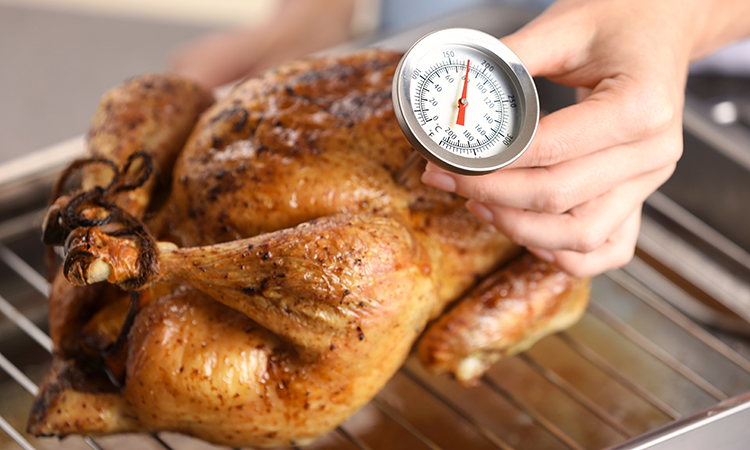Many US consumers unsure of how to heat food to prevent illness
- Like
- Digg
- Del
- Tumblr
- VKontakte
- Buffer
- Love This
- Odnoklassniki
- Meneame
- Blogger
- Amazon
- Yahoo Mail
- Gmail
- AOL
- Newsvine
- HackerNews
- Evernote
- MySpace
- Mail.ru
- Viadeo
- Line
- Comments
- Yummly
- SMS
- Viber
- Telegram
- Subscribe
- Skype
- Facebook Messenger
- Kakao
- LiveJournal
- Yammer
- Edgar
- Fintel
- Mix
- Instapaper
- Copy Link
Posted: 30 July 2024 | Leah Hockley | No comments yet
A new survey has found that many US consumers do not know the correct temperatures to heat food to in order to kill viruses, and are unaware of the risks of drinking unpasteurised milk.


In June, the U.S. Food and Drug Administration (FDA) reported in an open letter that bird flu, or the H5N1 avian influenza virus, has been detected in cow’s milk. The presence of H5N1 bird flu was confirmed in cattle in the US in mid-March 2024 and, as of 25 July 2024, there had been 13 human cases of bird flu in the United States since April 2024, four following exposure to cows and nine following exposure to poultry in Colorado. As of mid-July 2024, 168 cattle herds in 13 states – and over 100 million poultry in 48 states – were affected.
With bird flu virus detected in cow’s milk, US health authorities have warned the public against potential sources of exposure, including drinking raw or unpasteurised milk, and have reiterated a general warning that consuming uncooked or undercooked poultry or beef products can make you sick.
Relatively few people say that they drink raw milk. Only 3 percent of US adults report having consumed raw milk in the past 12 months, while 4 percent were not sure whether they had, according to a new nationally representative Annenberg Public Policy Center (APPC) health survey of nearly 1,500 empanelled US adults conducted in July 2024.*
But many more people say that they do not use a thermometer to ensure that their food is heated to a temperature high enough to kill bacteria and viruses – including avian influenza A viruses like the H5N1 strain now found in US cattle – and most are unsure what internal food temperatures kill bacteria and viruses, according to the survey.
Using a food thermometer
Only about one in four US adults (27 percent) report using a thermometer either “often” or “all the time” to check whether the meat, poultry or fish that they consume has reached an internal temperature that makes the food safe to eat. A similar proportion (29 percent) say that they “never” use a thermometer to check food temperatures, while 20 percent say that they do “rarely” and 20 percent “sometimes.”
“Using a food thermometer to determine that meat, poultry, fish and eggs have been cooked to a safe internal temperature, one that kills bacteria such as E. coli and salmonella, is a way of protecting yourself from food poisoning,” said Kathleen Hall Jamieson, Director of the Annenberg Public Policy Center of the University of Pennsylvania. “Every cook should have a food thermometer within ready reach in the kitchen or near the grill.”
The data come from the 20th wave of a nationally representative panel of 1,496 US adults, conducted for the Annenberg Public Policy Center by SSRS, an independent market research company. This wave of the Annenberg Science and Public Health (ASAPH) Knowledge survey was fielded from 11 July to 18 July 2024, and has a margin of sampling error (MOE) of ± 3.6 percentage points at the 95 percent confidence level.
Most unsure of correct food temperatures to kill viruses such as bird flu
According to the Centers for Disease Control and Prevention (CDC), “While there is no evidence that anyone in the United States has gotten infected with avian influenza A viruses after eating properly handled and cooked poultry products, uncooked poultry and poultry products (like blood) could have been the source of a small number of avian influenza A virus infections in people in Southeast Asia.” The United States Department of Agriculture (USDA) reported in May 2024, as part of testing of 96 dairy cows, that the virus had been detected in the meat of one “cull” cow but it did not enter the food chain and the USDA is confident that the meat supply is safe: “While we have multiple safeguards in place to protect consumers, we continue to recommend consumers properly handle raw meats and cook to a safe internal temperature.”
The APPC survey finds that most US adults do not know the correct temperatures to heat food to in order to kill the H5N1 virus, or bird flu. Thinking about the virus, the survey respondents were asked to indicate which of the measures below “will kill the H5N1 virus,” and to select all that apply. Over half of those surveyed (51 percent) indicated “not sure” on this item and 4 percent incorrectly said “none will kill”:
- Heating poultry to at least 165 degrees Fahrenheit (CORRECT): fewer than four in 10 (38 percent) selected this option as correct. According to the CDC, cooking poultry and eggs to an internal temperature of 165 degrees kills bacteria and viruses, including H5N1
- Heating ground beef to at least 165 degrees Fahrenheit (CORRECT): this is true, but less than one in three people surveyed (29 percent) selected it. In fact, the CDC recommends heating ground beef to at least 160 degrees
- Heating steak to a least 145 degrees (CORRECT): just over one in five (21 percent) selected this as correct. According to the CDC, whole cuts of beef should be heated to 145 degrees then allowed to rest for three minutes
- Freezing beef to a temperature of at least 20 degrees Fahrenheit (INCORRECT): only 7 percent chose this thinking that it is correct (it is not). Bird flu survives indefinitely while frozen and remains infectious, according to the Occupational Safety and Health Administration
- Heating beef to at least 120 degrees (INCORRECT): only 10 percent chose this, but it is not correct.
Raw milk and bird flu
As of mid-June 2024, the FDA concluded “that the totality of evidence continues to indicate that the commercial milk supply [which is pasteurised] is safe.” The FDA says that it does not currently know whether the H5N1 virus can be transmitted to humans through consumption of raw milk products from infected cows, though a study with mice concluded that the virus in “untreated milk can infect susceptible animals that consume it” and the National Institutes of Health (NIH) says this suggests that drinking raw milk “may pose a risk of transmission to people”.
The Annenberg survey finds that 15 percent of respondents think that drinking raw milk increases the chances of getting bird flu, while 33 percent think that it has no effect one way or the other on the chances of getting bird flu. Nearly half of those surveyed (49 percent) are not sure.
What people know of pasteurisation and the risks of raw milk
According to the CDC, pasteurisation “is crucial for milk safety, killing harmful germs that can cause illness” and the NIH says that “dairy milk purchased in the grocery store has been pasteurised – heated to a level high enough and long enough to kill most viruses or bacteria in the milk.”
Yet, the current survey shows that just over half of those surveyed (54 percent) know that unpasteurised milk is less safe to drink than pasteurised milk. While 6 percent say raw milk is safer to drink and 13 percent say it is just as safe, 27 percent say they are not sure which is safer.
The survey also finds that:
- Bacteria and viruses: 62 percent think that it is likely that raw milk contains bacteria and viruses that can make you sick, while 16 percent say it is unlikely and 22 percent are not sure
- Effectiveness of pasteurisation: 77 percent know that pasteurisation is effective at killing bacteria and viruses in raw milk, while 4 percent say it is not effective and 20 percent are not sure
- Nutrients: over a quarter of those surveyed (26 percent) say raw milk has more nutrients than pasteurised milk, 30 percent think it has “about the same amount of nutrients as pasteurised milk,” and 40 percent are not sure.
While those who advocate for drinking raw milk contend that pasteurisation destroys valuable nutrients, the FDA says that raw milk “is not nutritionally superior” to pasteurised milk.
*The percentage of raw milk drinkers found in the APPC survey, which included non-milk drinkers, is roughly consistent with a 2016 FDA food safety report, finding that 4 percent of US adults who drink milk reported having had raw milk over the prior 12 months. Unlike the FDA survey, the APPC survey gave people the explicit option of indicating that they were not sure.
Related topics
Contaminants, Food Safety, Refrigeration and freezing, Research & development, Temperature control, The consumer
Related organisations
Annenberg Public Policy Center (APPC), Annenberg Science and Public Health (ASAPH), Centers for Disease Control and Prevention (CDC), Food and Drug Administration (FDA), SSRS, United States Department of Agriculture (USDA), University of Pennsylvania









